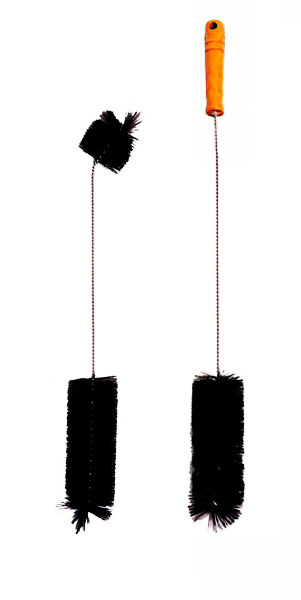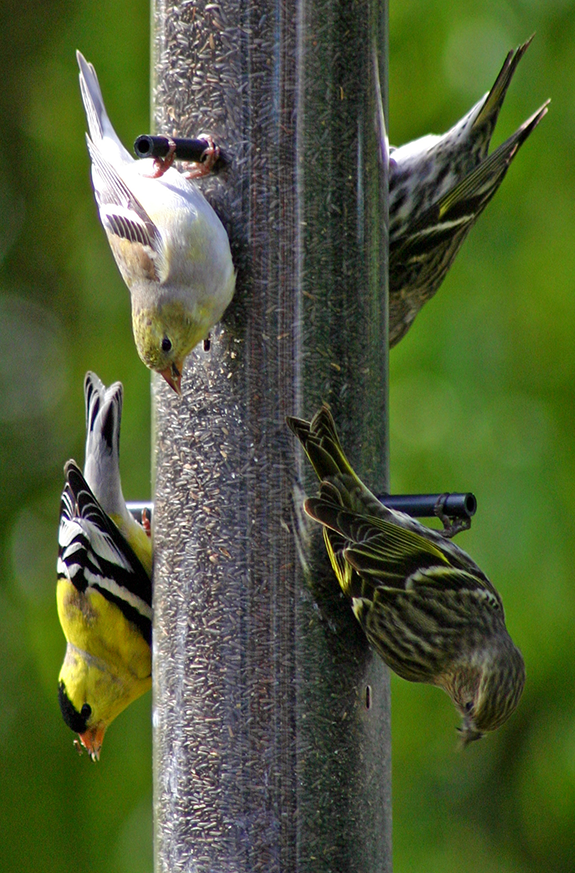Because clean feeders matter when it comes to the health and well-being of your backyard birds. It’s so easy to do and it makes a big difference! To understand why it’s important, also see ‘Quality Food & Clean Feeders Matter‘.
When to clean feeders:
Normally, we recommend every two weeks, more frequently as traffic increases and immediately any time you see signs of mold (find out more about mold in bird feeders here) or if you’ve seen a sick bird visit your feeder. If you’ve seen a sick bird at one of your feeders, there’s a chance it has visited one of your other feeders (or baths), too. If this happens, give them all a simple, but deep cleaning*.
* A deep cleaning is basically an energetic and thorough routine cleaning, with the addition of a good soak after scrubbing. You’ll use boiling hot soapy water with either a little added bleach or using equal parts boiling hot soapy water and white vinegar. Note: Don’t use bleach for your wood feeders as the smell of bleach may never rinse off! See our step-by-step guide for cleaning below.
What you will need to clean your feeders:
- A scrubbing brush or bottle brush that reaches everywhere.
- For routine cleaning – Soap and hot water. (Dish soap works great!)
- For deep cleaning – Bleach or vinegar. Below, see which is best for your feeder type.
How to clean (and deep clean) bird feeders
Deep Cleaning Metal, Acrylic, Recycled Plastic or Poly-Lumber Feeders
Deep Cleaning Diluted Bleach Solution:
10 parts hot soapy water to 1 part bleach.
This is the most effective option to eliminate mold and bacteria. Use for all feeders except those made of wood. If you’re not sure which cleaning solution to use, call us!
Deep Cleaning Wood Feeders, or as a Bleach Alternative for Other Feeders
Deep Cleaning Diluted Vinegar Solution:
Equal parts vinegar and hot soapy water.
For all other feeders, Bleach is the best at fighting bacteria. But used to clean a wooden feeder, the bleach smell may linger no matter how much you rinse. If you choose to use the vinegar solution for your other feeders, plan to leave them soaking soaking for at least an hour for the vinegar to be most effective.
- Dump out the food and dispose of it. Refill with fresh food after cleaning.
- Disassemble your feeder as much as possible, so you can give every part a thorough cleaning.
- Wash with soap and really hot water. Remove all visible debris with a good scrubbing.
- Soak!
- Routine cleaning: Soak at least 10 minutes in the hot soapy water.
- If deeper cleaning with bleach is needed: Add one cap of bleach to each gallon of water. It doesn’t take much! Soak for 30-60 minutes.
- Alternative for using bleach: Use equal parts white vinegar and hot water instead. Soak for at least 60 minutes.
- RINSE THOROUGHLY. Rinse just one more time after that! Rinse so well, you could eat out of it yourself!!! YES!!! It’s that important.
- Let feeder parts dry thoroughly and completely before you reassemble and refill.
- While your feeders dry, it’s a good time to rake up any food or debris beneath your feeders and throw it away.
- When your feeder parts are dry—really totally dry—reassemble and refill with fresh food.
Don’t forget to clean your Hummingbird feeders every 2-3 days and replace the nectar. See our Hummingbird page for feeder info.

The Backyard Naturalist stocks and recommends the Two-in-One 14″ cleaning brush (left). Great for Hummingbird feeders! And The Long Brush (right), with a 24″ reach for cleaning every nook and cranny, even in the longest tube feeders!






